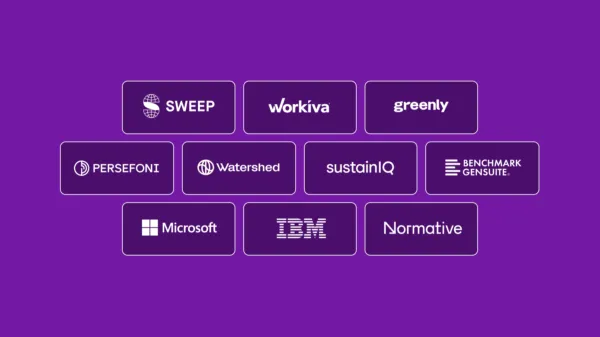Environmental, social and governance (ESG) reporting has shifted from a niche concern to a mainstream business priority. Once seen as a regulatory obligation or a reputational safeguard, ESG reporting is now widely recognized as a smart business tactic.
According to a 2023 McKinsey report, “More than 90% of S&P 500 companies now publish sustainability reporting, and investors increasingly use ESG factors to guide decisions.” That means ESG disclosure is no longer just about appeasing regulators — it’s about building trust, attracting capital, and managing long-term sustainability risks.
For U.S. companies, the growing number of both mandatory and voluntary ESG reporting frameworks can feel overwhelming. From California to the EU, jurisdictions are introducing sweeping legislation with global implications. Meanwhile, voluntary frameworks like CDP and GRI continue to shape stakeholder expectations.
This guide walks U.S. businesses through the current ESG landscape — what’s required, what’s recommended, and how to get ahead.
Mandatory ESG reporting frameworks for U.S. companies
While there is still no single federal ESG disclosure law in the U.S., several states — and international jurisdictions — have introduced mandatory ESG reporting obligations that apply directly or indirectly to American businesses. ESG reporting is becoming mandatory in more jurisdictions, especially for public and private companies, as ESG regulations and ESG reporting requirements continue to evolve.
California climate disclosure laws
In 2023, California passed two landmark climate disclosure laws: SB 253 and SB 261. These laws make California the first U.S. state to introduce mandatory, wide-reaching sustainability reporting requirements that focus on reducing environmental impact and require companies to provide accurate reporting data on their environmental impacts.
- SB 253 – Climate Corporate Data Accountability Act
Requires companies with over $1 billion in annual revenue doing business in California to publicly disclose their carbon emissions and greenhouse gas emissions, including Scope 3 emissions (indirect emissions from the value chain), as part of their climate disclosures. - SB 261 – Climate-Related Financial Risk Act
Applies to companies with over $500 million in revenue and mandates the disclosure of sustainability risks and how the company is mitigating them, based on frameworks like TCFD (more on that later). Companies must also assess and disclose climate risks and climate related financial risks as part of their climate disclosures.
These laws are significant not only because of their scale but because they apply to private and public companies alike — including non-California-headquartered firms with substantial business in the state.
New York’s Climate Leadership and Community Protection Act (CLCPA)
New York’s CLCPA mandates ambitious climate targets, including 85% emissions reductions by 2050. While direct ESG reporting mandates are limited so far, state agencies are increasingly integrating ESG metrics and climate risk disclosures into procurement, energy, and financial oversight — laying the groundwork for future mandates. Companies are now often required to demonstrate their sustainability performance as part of procurement and compliance standards. Integrating ESG data with financial reporting is becoming essential for audit readiness, regulatory compliance, and transparent disclosures.
In addition, the New York State Common Retirement Fund, one of the largest public pension funds in the U.S., now requires companies in its portfolio to align with ESG reporting frameworks. ESG standards play a critical role in guiding these disclosures, ensuring consistency and comparability. The information being disclosed increasingly includes corporate governance data, which demonstrates transparency and responsible business practices — a powerful driver of voluntary compliance.
CSRD – EU Corporate Sustainability Reporting Directive (impacting U.S. companies)
The CSRD, which came into effect in 2024, is a game-changer for international companies, including many in the U.S.
It applies to:
- U.S. companies with a subsidiary or branch in the EU generating over €40 million in net turnover
- U.S.-based multinationals listed on an EU-regulated market
Covered companies will be required to publish detailed ESG disclosures in line with ESG reporting standards, following the European Sustainability Reporting Standards (ESRS). This includes double materiality (impact and risk) across a wide range of ESG factors. To comply with the CSRD, companies must follow a structured reporting process, which involves steps such as establishing cross-functional teams, conducting materiality assessments, and aligning with recognized ESG frameworks.
SECR – the UK’s Streamlined Energy and Carbon Reporting (SECR)
Although UK-based, SECR affects some U.S. companies — particularly those with UK subsidiaries or listings. Under SECR, large UK-registered companies must disclose energy use, associated GHG emissions, and energy efficiency actions in their annual report. Companies are also required to report on their sustainability initiatives and ESG initiatives as part of these annual disclosures, demonstrating their commitment to responsible practices and environmental stewardship.
For U.S. businesses with qualifying UK entities, SECR is a mandatory ESG reporting obligation with real regulatory and reputational implications.
Voluntary ESG reporting frameworks
While mandatory rules are expanding, the majority of ESG reporting in the U.S. remains voluntary — shaped by global frameworks that guide how companies measure, disclose, and improve their ESG metrics.
Choosing the right framework(s) can help U.S. businesses proactively manage sustainability risks, attract investors, and build long-term value. Voluntary ESG reporting also supports companies on their sustainability journey by providing structure and guidance for continuous improvement. Many companies use ESG reporting software to streamline data collection and manage reporting data, ensuring efficient, accurate, and reliable communication with key stakeholders.
ISSB – International Sustainability Standards Board
Established under the IFRS Foundation, the ISSB launched its first two sustainability disclosure standards in 2023:
The ISSB integrates elements from TCFD, SASB, and CDSB, creating a comprehensive baseline for ESG transparency. The Sustainability Accounting Standards Board (SASB) has played a significant role in shaping global ESG disclosure standards by developing industry-specific standards that address material environmental, social, and governance issues relevant to financial performance and stakeholder decision-making. While not currently mandated in the U.S., ISSB standards are being adopted in multiple jurisdictions — and are increasingly seen as the global norm for ESG reporting.
GRI – Global Reporting Initiative
The GRI Standards are among the most widely used sustainability reporting frameworks globally, with a focus on stakeholder interests and impact materiality.
GRI is particularly strong in the social and governance areas of ESG and is frequently used by companies wanting to demonstrate a values-driven approach to business. The standards cover topics such as:
- Anti-corruption
- Human rights
- Diversity and inclusion
- Waste and resource use
GRI is often used in conjunction with other frameworks like ISSB or CDP to provide a fuller view of a company’s ESG factors. The United Nations Global Compact is another recognized global framework that is frequently used alongside GRI, highlighting a company’s commitment to responsible business practices and adherence to universal principles on human rights, labor, environment, and anti-corruption.
CDP – Carbon Disclosure Project
CDP is a global non-profit that operates disclosure systems for environmental data, especially around climate change, water security, and deforestation.
Each year, thousands of companies respond to CDP questionnaires — either voluntarily or at the request of investors and customers. CDP scores help stakeholders benchmark a company’s environmental performance, and high scorers often gain competitive advantages in supply chains or capital access. An ESG score, along with ESG scores from various third-party ratings, plays a crucial role in measuring and benchmarking a company’s overall ESG performance, influencing investment decisions and building investor trust.
TCFD – Task Force on Climate-related Financial Disclosures
Launched by the Financial Stability Board, the TCFD framework helps companies disclose how sustainability risks — particularly climate-related ones — impact their financial health.
TCFD’s four core pillars are:
- Governance
- Strategy
- Risk management
- Metrics and targets
Many frameworks — including ISSB and SB 261 — are based on TCFD principles, making it a foundational tool for businesses starting their ESG reporting journey.
How ESG tools can help businesses scale ESG reporting
With the rise of multiple ESG reporting frameworks, managing disclosures manually is becoming unsustainable — especially for companies reporting across jurisdictions. ESG reporting software is essential for streamlining data collection and managing reporting data across multiple frameworks, ensuring consistency and reliability for stakeholders.
That’s where ESG tools come in. These platforms streamline everything from data collection to reporting, turning a complex compliance process into a strategic asset.
Key benefits include:
- Automated data collection across business units, regions, and systems, streamlining data collection for greater efficiency and accuracy
- Real-time ESG metrics dashboards to support decision-making
- Audit-ready workflows that ensure compliance and traceability
- Framework-specific templates for GRI, CDP, ISSB, TCFD, and more
- Enhanced corporate governance through transparent ESG controls and reliable reporting data
Whether you’re preparing for California disclosures, EU compliance, or voluntary investor reporting, the right ESG software enables your team to track, align, and report with confidence.
Why Sweep stands out: Interoperability and scale
One ESG tool leading the way is Sweep — a carbon and ESG management platform built to support multinational businesses through flexible, integrated, and forward-looking solutions. Sweep assists businesses throughout their sustainability journey, from data collection to reporting and strategy implementation, helping them effectively manage and communicate their ESG responsibilities.
One upload, many uses: The power of interoperability
One of Sweep’s most valuable features is interoperability — the ability to upload your ESG data once, and use it across multiple ESG reporting frameworks.
Rather than preparing a different dataset for CDP, ISSB, SECR, and CSRD, Sweep allows you to map a single data input to the requirements of each framework. This means:
- Less time spent reformatting reports
- Lower compliance costs
- Greater consistency across disclosures
- More actionable insights from a unified dataset
This functionality is essential in today’s fragmented reporting environment. It not only reduces reporting fatigue but also supports integrated, strategic corporate governance across ESG domains.
Final thoughts: Start early, think big
As ESG expectations evolve, U.S. companies that treat ESG reporting as a strategic priority — not just a legal obligation — are best positioned for long-term success. Developing a robust ESG strategy and committing to a continuous sustainability journey are essential steps for companies seeking to maximize the benefits of early action.
Whether facing mandatory disclosures in California, the UK, or Europe, or aligning with voluntary ESG reporting frameworks, the goal is the same: create a transparent, data-driven view of your company’s impact and resilience through effective sustainability initiatives.
Investing in ESG tools and building capacity early will help your business navigate complexity, seize market opportunities, and demonstrate leadership in the global shift toward responsible capitalism.
The takeaway? ESG is no longer optional — but with the right approach, including a strong ESG strategy and meaningful sustainability initiatives, it’s a powerful lever for performance, resilience, and value creation. ESG reporting and sustainability initiatives are essential for building a more sustainable future, helping companies contribute to a sustainable future for society and the planet.




